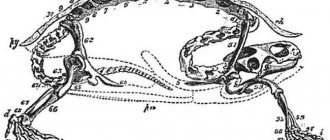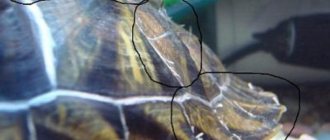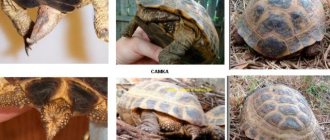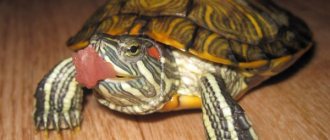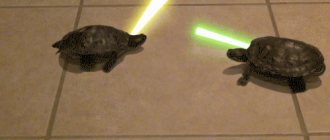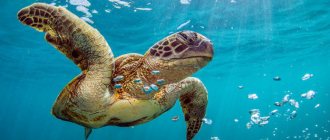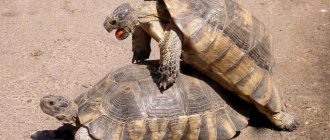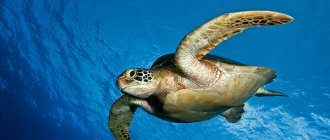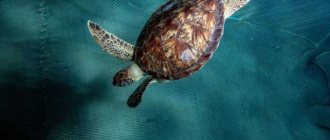Rest period
Adult coal turtles are sexually active almost all year round, so when breeding, you don't have to strictly adhere to seasonal rhythms. But it should be borne in mind that in nature they cease to be sexually active in October and November. Therefore, it is not necessary for coal turtles to hibernate - they are usually content with a short period of rest. In autumn, during a period of 2 weeks, from the beginning of October, the number of heating in the terrarium should be reduced, and the daylight hours will also decrease. When the day length reaches 8 hours, feeding of turtles stops. They also stop spraying the litter. When daylight hours drop to 4 hours, you can turn off the heating. Now the temperature in the terrarium should be approximately 20 degrees.
Humidity is maintained by rare, once a week, spraying of the litter. Then the turtles are given a drinking bowl, and it is taken out when they have drunk. If the turtles are healthy, the rest period should last about a month.
Turtles should be brought out of the dormant period gradually, in a similar manner, increasing daylight hours. When it reaches 6 hours, you can turn on the heating and offer food to the turtles, and put a drinking bowl in the terrarium. By gradually increasing the daylight hours, it will be possible to arrange for turtles to imitate the rainy season, abundantly irrigating the substrate with warm water, or use a special rain installation or fog generator, which should be set to work 4-5 times a day for 3 minutes. The simulation should be continued for a month.
Interesting Facts
- The turtle will never be able to leave its shell, because it has become fused with it;
- The cervical vertebrae are so elastic that they allow you to rotate your head, stick it out or hide it in moments of danger;
- The reptile is able to completely hide all parts of the body inside the shell;
- Although the shell is protection, it can also expose to damage;
- The turtles were in orbit, from where they returned alive;
- They do not have vocal cords, but are capable of making sounds, this occurs by quickly squeezing out a stream of air;
- The glands present in the cloaca secrete pheromones, which the male can hear at a distance of several kilometers;
- Good blood supply to the cloaca allows gas exchange through it;
- These reptiles can live up to hundreds of years;
- Not all of these animals are herbivores; they can even eat their own kind, killing them with their massive beak and tearing them apart with their powerful paws.
The turtle has a very interesting body structure. Her body has nothing superfluous, all formations perform a specific function. More detailed information about the structure of the turtle body can be found by reading specialized literature. By the way, it can be purchased in bookstores. Studying the structure of reptiles helps to better understand its habits and food preferences. Create the most favorable conditions for their maintenance.
The body is enclosed in a bony shell, covered on top with horny scutes or skin (in the Far Eastern). The head on a long, movable neck, like the legs, can usually be retracted under the shell. There are no teeth, but the jaws have sharp horny edges. Eggs with a hard, calcareous shell.
Plastron and its meaning
The lower part of the shell is called the plastron. Between it and the carapace is the soft body of the animal. Both halves of it are united by a bone shell. The plastron itself is an anatomical derivative of the girdle of the forelimbs and ribs. It is as if “soldered” into the body of the turtle. Terrestrial forms have a massive plastron. And in marine inhabitants it is reduced to cruciform plates located on the abdominal part of the body. Due to growth, concentric lines are formed on the scutes of the shell. From them, herpetologists can determine the age of the turtle and its state of health.
The unique structure of sea turtles
The anatomy of the sea turtle is unique in that it is one of the few creatures that have both an internal and external skeleton. In all species, with the exception of leathery ones, the external frame provides protection and support for the internal organs. It consists of a bony shell, which, in turn, is divided into two halves: the lower and upper armored plastron. Muscles are attached to the internal skeleton. Like land turtles, the spine of sea turtles is fused with the shell.
The long fingers on the limbs form flippers, which are used to move in the water. They are also used by females to dig holes for eggs during the nesting season. Sea turtles have no teeth in their mouths. Instead, there is a sharp beak with which you can crush food. The leathery mouth contains a number of undeveloped spines.
Spine
It has cervical, thoracic, lumbar, sacral and caudal sections. Cervical, has eight vertebrae, several anterior ones are connected to form a movable joint. The vertebrae of the body are connected to the ribs. The upper vertebrae, together with the sternum, actually form the chest and cavity, which contains important internal organs. The pelvic bones are attached to the sacral vertebrae. The caudal vertebrae are represented in large numbers; they do not bear any special functional load. The turtle's skull is represented by a large number of bones. It has two sections, cerebral and visceral.
Turtle and common musk turtle
These turtles are commonly mistaken for snapping turtles. The banded turtle is not very common in North Carolina. It is found only along the northwestern border of the state in two counties. The common musk turtle can be found throughout North Carolina.
This turtle also bites when first picked up. There are seven species of sea turtles, which are marine reptiles that need to exhale air to survive. They return to shore to lay eggs, often making long journeys to visit specific beaches each year.
The eyes are located on the side of the head, looking down. These animals eat with the help of a hard beak, which has irregularities similar to teeth. The turtle's head has a fairly streamlined shape, which gives it speed to the marine species.
The turtle's brain has two sections, the head and the dorsal. Despite the fact that the brain is very small in size. Most of the functional load is borne by the spinal cord.
They face many human threats, including entanglement in fishing gear, marine debris, destruction of coastal habitats, poaching of adults and eggs, and climate change. There are also advances in sea turtle conservation. On the coast of Mexico, one community hangs lights in their fishing nets so turtles can avoid them. They found a 50 percent reduction in turtle catches at night, while fish catches actually increased.
Every year, in the same place and time, thousands of Kemp's sea turtles come ashore to nest and lay eggs on the beach. Flatback turtles tend to spend most of their time on the surface of the ocean, often with a bird using their shell as a small landing space, ideal for a break.
Variety of species
There is no point in listing all types of land turtles or their aquatic relatives. The variety of reptile species is simply amazing. Currently, scientists believe that there are more than 300 types of reptiles. Each species is necessarily different in some way, be it the structure of the shell or the animal itself, coloring, habitat. Animal lovers often choose species of aquatic turtles to keep.
Pond slider
Perhaps the red-eared slider is the most popular reptile chosen for captivity. This turtle has a red spot located near the ears - this is how it earned its name. The red-eared turtle is an aquatic reptile, so keeping it requires a spacious aquarium. However, we should not forget about setting up a small island on which the animal will periodically go to rest.
On average, the length of the red-eared turtle is no more than 30 cm. The reptile feeds on animal food: fish fry, small fish with bones, shrimp, small crustaceans. You can give your pet insect larvae and small frogs. To diversify your diet, it’s a good idea to add plants to it. With proper care, the red-eared slider will be very active. If you plan to keep several individuals at once, then you are guaranteed to enjoy the fun games of your pets.
The types of land turtles are quite diverse. One of their representatives is the Central Asian tortoise. This reptile is distinguished by its slowness. The color of the turtle is beige-yellow, with black inclusions in places. The length of the animal’s shell is 20-25 cm. At the moment, this species of reptile is in the Red Book, but to this day it remains the most popular species of land turtles.
To maintain a home, prepare an enclosure for the Central Asian tortoise with a volume of at least 100 liters. There must be soil in it. It is advisable to pour a fairly large amount of sand or pebbles - land turtles love to dig holes. The reptile's diet should consist entirely of plant foods. You should not give meat to your pet. Only occasionally, as an exception, can you pamper him with insect larvae in minimal quantities.
This type of turtle, the Chinese Trionix, is becoming increasingly popular. The main distinguishing feature of the reptile is its shell. Trionics Chinese belongs to the order of soft-bodied turtles. There are no horn plates on the carapace; it is covered with leather. However, the soft shell does not in any way prevent the reptile from showing its aggressive character.
Trionix Chinese has very powerful jaws. Although a turtle's teeth are replaced by horny plates, the bite of such a reptile can be very noticeable and lead to injury. That is why it is recommended to purchase a pet at a young age. Trionics Chinese is in the Red Book, but many pet stores ignore this and continue to sell this type of reptile.
The species of aquatic turtles suitable for home keeping are supplemented by another representative of the animal world - the European marsh turtle. Its main distinguishing feature is that both the shell and the body of the animal are painted black. Only in places you can find yellow stripes or dots, but they are very inconspicuous.
It attracts reptile lovers for several reasons. Firstly, it is rightfully considered a small representative of turtles. The length of its shell does not exceed 14 cm. Secondly, the reptile has a very interesting appearance, which is striking in its originality.
All of these are domestic turtles, the species of which are very diverse. In fact, you can keep absolutely any reptile at home, the main thing is to create suitable conditions. However, the turtles listed above are the most popular.
The types of aquatic turtles and the types of land turtles are very diverse. The world of reptiles is very interesting. If you study it, you can learn a lot of new information. For example, you might be amazed by the size of the smallest turtle. The appearance of some reptiles will also not leave you indifferent. If you want to have such a wonderful pet as a turtle, take an interest in the life of reptiles.
The turtle is a beautiful animal belonging to the order Reptiles. Turtles are considered the oldest creatures that were among the first to appear on earth. In the wild, these animals live in the tropics, as well as in places with a predominant temperate climate. Turtles can live both on land and in water.
Today, terrestrial species have become actively used as pets. Let's look at the main types of domestic turtles.
Terrestrial turtles are divided into two types:
- land;
- freshwater
Signs of diseases
The shell can tell about many diseases that an amphibian animal may suffer from. For this reason, owners should inspect this part of the body from time to time so as not to miss suspicious signs.
Rickets or vitamin D3 deficiency
- deformation of limbs and shell;
- increased bone fragility;
- prolapse of the cloaca;
- the reptile cannot rise to its feet normally;
- redness of the mucous membranes of the eyes is noted;
- disruption of the digestive system;
- change in bite.
All these signs pose a serious danger to the life of the turtle. If treatment is not started in time, serious consequences can occur, including death.
So what should you do if your turtle has a soft shell? It is advisable to review the diet at home and include feed mixtures with high levels of calcium, as well as other vitamins. In addition, you need to contact a veterinarian.
Dermatitis, fungus
- peeling and peeling of the skin in the area of folds;
- the turtle's shell turns white;
- the appearance of acne and swelling on the skin;
- severe itching, for this reason the reptile itches a lot;
- the appearance of a large number of ulcerative formations on the animal’s body.
If a turtle has white spots on its shell, this is a clear sign that it has dermatitis or a fungus
To ensure that the shell does not peel off and become covered with ulcers, you should pay attention to the aquarium, clean it well, and change the water. If a turtle has white spots on its shell, which are accompanied by peeling, then it is advisable to contact a veterinarian, a specialist will recommend effective medications for treatment
Effective drugs include:
- Baytril;
- bathing with betadine. All areas that have turned white will quickly return to normal;
- adding methylene blue to the aquarium water;
- Lamisil;
- Nizoral;
- inclusion of essential vitamins in the diet;
- ultraviolet irradiation.
It is important to properly care for the shell and monitor its condition. If you follow the rules of caring for your turtle, you can avoid all unpleasant diseases.
The main thing is that the pet develops and grows properly, and for this you need a balanced and healthy diet high in vitamins. This is also necessary to strengthen the structure of the shell.
source
Parietal bone
os parietalefacies externatuber parietalelinea temporalis superiorlinea temporalis inferiorfascia temporalismtemporalisfacies internaimpressiones digitataesulci arteriosiameningea mediasulcus sinus sagittalis superiorisfalx cerebriforamen parietalefoveolae granularessulcus sinus sigmoideimargosagittalissutura sagittalismargo squamosussutura squamo sasutura parietomastoideasutura sphenoparietalismargo frontalissutura coronalismargo occipitalissutura lambdoideaangulus frontalisangulus sphenoidalisangulus occipitalisangulus mastoideusincisura parietalis
turtle shell
The shell is one of the most characteristic features that distinguishes a turtle from other reptiles. The armor is quite strong. Some species can withstand pressure within their protective shell that is 200 times the weight of the animal itself. Typically, the shell consists of two layers: outer and inner, also called keratin and bone. The first is represented by scutes, and the second by plates.
A turtle shell looks beautiful, but its main function is protection.
What does a turtle shell look like?
The shell consists of two parts: dorsal and abdominal. The cover is very powerful and is able to withstand heavy pressure loads from the jaws of predatory animals that hunt reptiles.
If we talk about appearance, then, as a rule, it is a yellowish-brown body in the form of an oval or circle. On top it is covered with keratinized polygonal plates, and inside it is lined with bone tissue. The same polygons can be observed on the abdominal region, but there they are flatter and more slippery.
Depending on the type of animal and habitat, the protective layer changes its color and is also covered with various bulges and even spikes.
Structure under the shell
What is a turtle shell made of?
The design of the shell is as follows. There is a dorsal shield called the carapace and an ventral shield called the plastron. The first is formed by bone plates. They fuse with the ribs and spine. The second, in most of these reptiles, consists of the sternum, ribs and collarbone.
Important! In almost all reptiles of this type, the shell is covered on top with symmetrical patterns in the form of keratinized scutes. The exception is soft-bodied and leatherback turtles, whose armor is a thick and rough layer of skin
Can a turtle live without a shell?
Along with the question of what a turtle's shell is made of, people often ask about the possibility of this reptile living without its protective armor. You can immediately say that the animal will not be able to live like that. The shell contains the spine, and therefore the spinal cord. Removing it would mean instant death.
Appearance of a terrarium for a land turtle
If you try to detach the protective shell without a spine, the turtle will look like a person without skin and will also not last long. Even newborn animals have a shell, but it is very thin, soft and not keratinized.
Despite this, there are some species of reptiles that are born and live without a shell. These include soft-bodied and leatherback turtles. They are adapted to an aquatic lifestyle. They are characterized by a protective layer of soft leather, which can be smooth, textured or even spiky.
Important! If we talk about domestic turtles, then no one keeps such species without a shell. This is justified by the fact that they live in fresh or slightly salty waters, and it is problematic to recreate such conditions at home
Origin of the name
If we consider the Slavic and Latin origins of the name of the reptile, it is easy to see the commonality. Both languages demonstrate a response to appearance in the word: translated from Latin “tile”, “clay vessel”, “brick”; from Slavic - “shard”.
Indeed, many turtles resemble the stone for which the people who gave them this name mistook them. Despite this etymology of the name, it also contains an indication of the unique shape and color of the hard shells.
Types of turtles
Turtle species are divided into two main types - land and freshwater. Each species includes subspecies that have distinctive features in appearance, habits and conditions of detention. If you study them all, you can easily select a suitable individual for keeping it at home.
Land species of turtles
This species includes turtles that live in steppe, arid and humid zones. Despite the fact that they are accustomed to conditions of drought and lack of water, they still require moisture for their comfortable existence; without it they simply cannot live.
Central Asian species
Reptiles of this species are clumsy. It is for this reason that they move very slowly from one place to another. This variety is considered very rare, so it is listed in the Red Book. Reptiles are prohibited from sale, but can sometimes be found for sale in some pet stores. In natural conditions, they live in the countries of Central Asia.
Main characteristics of the Central Asian turtle:
- they have a strong shell with a durable structure. It has a round shape. Its size can reach up to 20 centimeters;
- the surface of the shell is colored yellow-brown;
- the carapace has dark-colored scutes; these elements usually have an indefinite shape;
- The front paws have 4 toes.
A turtle of this species can live on average 40-50 years. This variety can be kept at home.
Galapagos tortoise (elephant)
Turtles of this species live in the Galapagos Islands. When kept in a climate with high humidity, individuals of this species acquire a round shape and also increase in body size. In arid regions, turtles, on the contrary, are quite small; the weight of males usually does not exceed 54 kilograms. In addition, they have thin and long legs.
Main characteristics of the individual:
- The length of the shell in reptiles of this species can reach up to 1.9 meters;
- the body weight of a turtle can be above 400 kilograms;
- these individuals are considered long-lived. They can live up to 170-200 years.
Mediterranean
This group of turtles, which includes about 20 subspecies. This breed can live in different regions with different climatic conditions. Reptiles of this species prefer to live in areas with increased amounts of sunlight, so they choose places with direct sunlight.
What features should you pay attention to:
- the reptile's shell has a strong structure;
- the largest size of the shell can be 35 centimeters;
- in the back of the amphibian there is horny tissue that looks like a bump;
- there are 5 toes on the front paws;
- the hind legs have the appearance of spurs.
Note! Mediterranean tortoise is suitable for home keeping
But it is important that the temperature indicator should be 25-30 degrees Celsius
Egyptian
This species primarily lives in Egypt and Israel. For her, the most important indicator is the temperature; it should be around 25-30 degrees. Reptiles have one characteristic feature - if they sense approaching danger, they immediately begin to bury themselves in the sand.
Important appearance features:
- this species has the smallest size, unlike its relatives;
- the largest shell size can be 12 centimeters;
- the surface of the shield is painted yellow, while it has a frame with a dark color;
- there are no spurs on the back of the legs.
Balkan
Turtles of this species live mainly in Southern Europe, near the sea. Amphibians that live in the western part have small body sizes, unlike individuals in the eastern part.
Appearance characteristics:
- Externally, the Balkan tortoise is similar to the Mediterranean reptile breed. But the difference lies in the size of the diameter of the shell; in individuals of this species it can be 15-20 centimeters;
- The carapace is painted in a light shade, with patches of dark color on it;
- The older the individuals, the darker the surface of the shell;
- Turtles have a spike at the end of their tail.
Balkan tortoise can be kept at home
But at the same time, one important condition must be observed - the air temperature in the place where it is kept must be within 26-32 degrees Celsius
Types of freshwater turtles
European marsh turtle
This species has 13 subspecies. The turtle's shell is low and smooth. The length of the animal is about 35 cm, the average weight of individuals is approximately one and a half kilograms. The color of the shell of turtles is dark green. The head, neck and paws are covered with light spots. The fingers have large, sharp claws and webbing. The species is characterized by a fairly large tail, the length of which is ¾ of the length of the turtle’s entire body.
In the wild, these animals can be found in different regions of Russia, Belarus, Armenia, Georgia, etc. Ideal habitat conditions for the species are lakes and ponds. Individuals are most active during the day. The species is one of those listed in the Red Book. Keeping it at home requires a temperature of 22-25 degrees and air temperature of about 30.
Pond slider
Of all the species, city dwellers most often breed this one in their aquariums and terrariums. All 15 subspecies of red-eared turtles are classified as so-called decorated. They received this name because of the red or yellow spots that are located near the ears. The size of individuals is about 18-30 centimeters. Young turtles have a lighter shell color. The head and paws are decorated with stripes of rich green color. The species has sexual differences: males have a more powerful tail and nail plate.
In the wild they are found in Mexico, America, the USA, and less often in Australia, Spain, Great Britain, and Israel. The optimal habitat is marshy shores of water bodies and ponds. Individuals of the species are very lazy, slow and inactive. At home, turtles must be kept at a water temperature of about 28 degrees, air temperature of 32.
Far Eastern turtle
Another name for the species is Chinese trionix. These individuals are the exception to all the rules. The fact is that, unlike the usual hard shell, these turtles have a soft “house”. Dimensions reach 20 cm, the surface of the shell is leathery, soft, without scutes, green in color.
This is not to say that the shell is the only part that can surprise this species. It is a little unusual to see a trunk instead of a nose and to observe that there are only three toes on the paws. If somewhere in China a small trunk sticks out of a pond, you need to remember that this is a feature of Far Eastern turtles. At first glance, this species is very cute and completely defenseless, but they have a secret here too. Trionix's jaws have special sharp edges, thanks to which the animal can grab prey. In addition, it is worth noting the increased mobility of individuals and the speed of reaction.
For humans, these turtles are also very dangerous, as they often show aggression, bite and are very difficult to tame. The only option to find a common language with individuals is to raise them in captivity from birth. The main habitats are China, Japan, and the Russian Far East. The most popular habitats are bodies of water characterized by weak currents. The Chinese and Japanese value the meat of these turtles very much and consider it a delicacy. Closed terrariums for keeping at home require maintaining a water temperature of about 26 degrees and an air temperature of 32.
Caspian turtle
Individuals of this species have a flat, oval shell with an average length of 30 cm. The color is dark green with yellow stripes. Stripes can also be noted on the head and limbs. There are also sexual differences in the species: males have a concave carapace and a thicker and longer tail.
In the wild they are found mainly in Southern Europe, the Arabian Peninsula, the Caucasus, Iraq, and Iran. The most favorable habitat conditions are bodies of water with both fresh and salt water, with the presence of coastal vegetation. This species of turtle has the unique ability to climb mountains to great heights and live for about 30 years. To keep them at home, a certain temperature is required: water -18-22 degrees, air - 30-32.
Common mistakes about turtles
- UV lamp
UFO – Unidentified flying object (i.e. UFO). And the lamp is Ultra Violet. - Amphibian turtle
Amphibians are amphibians (frogs, salamanders, etc.), and turtles are reptiles or reptiles. - Mediterranean tortoise
There is a (Central) Asian tortoise and a (Mediterranean) tortoise. - Sea red-eared turtle
Turtles are divided into freshwater, sea and land (+ secondary land). If a turtle does not live in salt water, then it is freshwater or simply aquatic, but not sea. - Breed
of turtle Reptiles do not have breeds - only species and subspecies. Cats and dogs of different breeds remain the same species. - Gammarus are dry shrimps.
Gammarus are dry small freshwater amphipods.
Domestic turtles, the species of which are very diverse, are very popular among lovers of living corners. Although these reptiles are completely wild and are virtually incapable of being kept in captivity as adults, the demand for them is steadily increasing. If you take a turtle very small, it will get used to you, will take food from your hands, and will certainly delight you with its fun games. To provide proper care for your pet, you definitely need to know.
All turtles are divided into two large types: aquatic and land. Aquatic turtle species are much more diverse than land turtle species. This article will answer your question, what types of turtles are suitable for home keeping, and which reptiles are the most popular.
Leather
Turtle skin has two main layers: the dermis and the epidermis. The epidermis covers the entire body and shell. Molting in turtles occurs gradually, and the epidermis is replaced as it wears out. A new one forms under the old stratum corneum. Lymph passes between them and fibrin-like proteins sweat out. Next, lytic processes occur, which leads to the appearance of a cavity between the new and old stratum corneum and their separation.
Land turtles only shed their skin. The shell scutes and large scutes on the paws and head should not shed. In young freshwater reptiles, the skin almost does not shed, but the shell scutes can be replaced. The formation of large leather covers, scales, armor plates, claws and rhamphotheca (horny covers of the jaws) is associated with the epidermis.
The epidermis is divided into:
- cuticular,
- beta carotene,
- alpha keratin,
- grainy,
- germinative.
The dermis is divided into spongy and compact.
Turtle skin has virtually no glands and is elastic, dry and durable. Has a tendency to curl up along the edges of the cut. When a turtle is on land , its skin almost completely blocks the evaporation of moisture, but easily lets warm water in if the turtle is in it. This mechanism helps reptiles maintain water balance.
How to properly set up a terrarium for a land turtle
For a long and healthy life of a pet, it is important to properly equip a terrarium for a land turtle, then the reptile will delight its owners for 25-30 years or even more
Floor filler
Turtles have a natural need to dig, so keeping them on a smooth surface can lead to deformation of their paws. The bottom of the terrarium should be filled unevenly, alternating areas with large pebbles with areas with sand in which the reptile can burrow.
Important! The soil layer should be thick enough for the turtle to burrow into it freely
Lighting and the right temperature for land turtles
For a comfortable existence for the reptile, the turtle terrarium is equipped with two lamps:
- for heat and lighting, incandescent lamp 40-60 W or infrared. Place the light source at a height of about 30 cm in the corner of the terrarium opposite the house; place a rough, unglazed tile under the lighting fixture so that the reptile can warm itself;
- An ultraviolet lamp imitates sunlight, which is necessary for the best absorption of calcium and vitamin D and for the prevention of rickets. It is better to take a reptile lamp that emits 10% UVB, i.e. 10.0.
Note! It is not recommended to use a lamp whose packaging does not indicate the percentage of UV rays: at best it will be useless, and at worst it can harm the health of the pet
Lighting and warmth are important factors in your pet's health.
Turtles feel comfortable at temperatures between 26 °C and 30 °C. If the heat in the reptile’s corner is not enough, you can additionally install a heater in the terrarium. To control temperature and humidity, a thermometer and hygrometer are placed in the upper part of one of the walls.
A measured rhythm of life is an important condition for the health and psyche of a pet, so you should turn the lamps on and off at the same time. Important! Lighting and heating devices must be placed in such a way that the reptile cannot reach them, this will help avoid burns or electric shock. Important! Lighting and heating devices must be placed in such a way that the reptile cannot reach them, this will help avoid burns or electric shock.
Important! Lighting and heating devices must be placed in such a way that the reptile cannot reach them, this will help avoid burns or electric shock.
Feeding area
The turtle will constantly try to knock over the feeder; it is better for your pet to use a heavy ceramic bowl. It is fixed or buried in the ground in a warm part of the terrarium.
Reptiles drink water, so you should not forget about the drinking bowl; it should also be securely fastened. The best option would be a special purchased drinking bowl for terrariums.
For your information! Live plants should not be placed inside the terrarium: the pet can eat them and get poisoned, and besides, watering the vegetation will increase air humidity, which is not beneficial for turtles.
Requirements for a house for a land turtle
Despite the fact that the turtle has its own “house”, which is always with it, the animal needs a cozy place where it can hide from prying eyes. Half a flower pot, a food-grade plastic container, or a home-made wooden house are suitable as housing.
Ventilation
Reptiles must get enough fresh air; stuffy rooms are destructive for them. The optimal design of a terrarium is a wide tray with low sides.
Note! If the turtle territory is covered with a lid, a sufficient number of ventilation holes should be provided in the walls and roof of the home.


